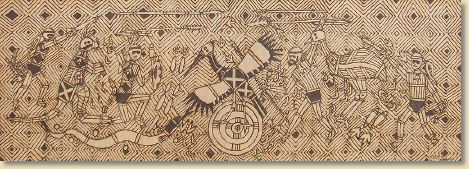| 
Colin Isaacs, from the Myall Creek Memorial Committee, presents to Revd Dr John
Brown a decorated urn he made to honour John and his contribution to the Myall
Creek project.
Myall
Creek Memorial Photo Gallery

Art Galleries
Ceramic
Break Sculpture Park - Warialda NSW
Australia
Agora
Gallery - Chelsea, New York USA
English as a second Language
Online Masters in ESL Programs
Master's degree programs for ESL education provide instruction
about how individuals learn English as a second language with regards to
writing, reading and speaking. Most programs are available for both
inexperienced and veteran teachers and intended for those looking to teach in
primary, secondary or post-secondary schools.
Tourism & Culture of Australia
http://www.australia.com/ProcessSplashResults.aust?C=AU&L=en
http://www.walkabout.com.au/
http://www.csu.edu.au/australia/
http://www.mainzdidgeridoos.com.au/
http://www.whitepages.com.au/wp/
http://www.yellowpages.com.au/search/searchEntry.do
http://www.atn.com.au/
Myall Creek Massacre
MyallCrk.html
Myths & legends - Australian Aborigine
http://www.cs.williams.edu/~lindsey/myths/myths_13.html
http://www.dreamhawk.com/oz.htm
moon.html
platypus.html
The
Mother Snake
Place Of Falling Star
http://www.dreamtime.net.au/

Foto Search Stock Photos contains over 200 Aboriginal art images and paintings.
Visitors can also find royalty-free clipart pictures, illustrations, stock video
clips, maps, and more.
http://www.fotosearch.com/photos-images/aborigine-art.html
use search term: aboriginal http://www.canstockphoto.com/
Colin Isaacs' Woodburnings

Wooden
Giftware
The Yowie, Hairy Man - Australia's Big Foot
http://www.yowiefile.com/
Aboriginal Art & Culture
http://www.aboriginalaustralia.com/aboriginal.htm#
http://aboriginalart.com.au/
http://www.karinya.com/auart1.htm
http://www.insects.org/ced1/aust_abor.html
http://www.mosman.nsw.gov.au/community/friendship/glen-innes
Yorta Yorta struggle for
Justice Continues
http://www.infoplease.com/ce6/society/A0805377.html
http://www.sl.nsw.gov.au/links/abor.cfm
Aboriginal Art
Yuinart
- Lloyd Hornsby
Aboriginal Message Sticks
http://www.schools.ash.org.au/elanorah/absticks.htm
http://www.bluep.com/~stiffe/message8.html
http://www.abc.net.au/message/
Didgeridoos:
Didgeridoos
and Oddgeridoos Traditional and Non Traditional Agave
and Split Didgeridoos
Decorated and Non Decorated Beginner
to Professional
Phillip
Jackson Didgeridoo performer
Mick
Lawton Didgeridoo Performer
Lachlan
Hinds Didgeridoo Performer
http://aboriginalart.com.au/didgeridoo/music.html
http://www.mainzdidgeridoos.com.au/
Australian History
http://www.nla.gov.au/oz/histsite.html
http://www.kooriweb.org/foley/indexb.html
Australian Museum On-line
http://www.amonline.net.au/
Books on Aboriginal Culture & History
http://www.dropbears.com/b/broughsbooks/history/aboriginal.htm
Oracle
of the Dreamtime
Gaddi Mirrabooka
http://www.aiatsis.gov.au/
Images
Stock Photos: http://www.gograph.com/
http://www.rosezone.com/postcards/images/1367-JPEG.html
http://www.pictureaustralia.org/
http://www.australienbilder.de/e-index.htm
http://www.mike-fields.com/outback/
News
http://www.aboriginenews.com/
http://www.koorimail.com/
http://www.murriviews.com.au/
Maps of Australia
http://www.ga.gov.au/map/images.html
http://www.maptrax.com.au
Storytelling Links
Australian Storytelling Guild
NSW inc
http://storyteller.port5.com/
Didgeridoos and Oddgeridoos
New
England Woodturning Supplies
Rob Day - Player - Maker
- Didgeridoos and Oddgeridoos - individually hand crafted to be
played.
Didgeridoos
Kristian Benton Didgeridoo craftsman
and player
www.yidakivibes.com
The Australian government and all its agencies have formally accept didjeridu as the correct spelling.
Didjeridu is sometimes spelt didgeridoo, didjeridoo and didgeridu, but However, since didgeridoo is the more popular way of spelling, didjeridu and didgeridoo are used interchangeably throughout the Internet
and print media. Another common term these days is yidaki, a type of didjeridu used by the Aboriginal people of north-east Arnhem Land who call themselves Yolngu. You may sometimes also see yidaki spelt as yidaki, yirdaki or yiraki, but yidaki is the orthographically-correct spelling.
The term didjeridu is onomatopoetic and not of indigenous origin. That is, didjeridu is a word of Western invention, first coined in the early part of the 20th century to describe the sounds made by the instrument. It is also fairly certain that the earliest usage of the expression applied to instruments encountered in Western Arnhem Land or in the region to its immediate south, where repeating rhythms or sound patternings such as "didjeridu-dideru", "didjemro" and "didjeramo-rebo" are found. However, today, the word didjeridu is used much more generally to include instruments originating from all parts of Aboriginal Australia as well as a broad spectrum of instruments produced by indigenous and non-indigenous makers utilising an array of modern materials and methods.
The didjeridu has also been embraced by modern society for a number of other reasons including the relaxing and mildly euphoric state that playing and listening to the didjeridu can bring about. It appears likely that the special breathing technique needed to play the didjeridu as well as the distinct acoustics of the instrument both have positive effects on inducing the alpha brain wave patterns that are associated with deep meditation.
YouTube Video
featuring Colin's Art and Kristian
Benton on Didgeridoo
https://youtu.be/ViHyQ_3oqA0
External links are
provided for your convenience, but they are beyond the control of the Website
Owner and no representation is made as to their content. Use or reliance on any
external links and the content thereon provided is at your own risk. When
visiting external links you must refer to that external websites terms and
conditions of use.
|

